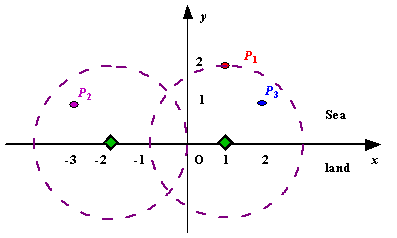Radar Installation
| Time Limit: 1000MS | Memory Limit: 10000K | |
| Total Submissions: 64472 | Accepted: 14497 |
Description
Assume the coasting is an infinite straight line. Land is in one side of coasting, sea in the other. Each small island is a point locating in the sea side. And any radar installation, locating on the coasting, can only cover d
distance, so an island in the sea can be covered by a radius installation, if the distance between them is at most d.
We use Cartesian coordinate system, defining the coasting is the x-axis. The sea side is above x-axis, and the land side below. Given the position of each island in the sea, and given the distance of the coverage of the radar installation, your task is to write a program to find the minimal number of radar installations to cover all the islands. Note that the position of an island is represented by its x-y coordinates.

Figure A Sample Input of Radar Installations
We use Cartesian coordinate system, defining the coasting is the x-axis. The sea side is above x-axis, and the land side below. Given the position of each island in the sea, and given the distance of the coverage of the radar installation, your task is to write a program to find the minimal number of radar installations to cover all the islands. Note that the position of an island is represented by its x-y coordinates.

Figure A Sample Input of Radar Installations
Input
The input consists of several test cases. The first line of each case contains two integers n (1<=n<=1000) and d, where n is the number of islands in the sea and d is the distance of coverage of the radar installation. This is
followed by n lines each containing two integers representing the coordinate of the position of each island. Then a blank line follows to separate the cases.
The input is terminated by a line containing pair of zeros
The input is terminated by a line containing pair of zeros
Output
For each test case output one line consisting of the test case number followed by the minimal number of radar installations needed. "-1" installation means no solution for that case.
Sample Input
3 2 1 2 -3 1 2 1 1 2 0 2 0 0
Sample Output
Case 1: 2 Case 2: 1
Source
#include<iostream>
#include<cstdio>
#include<cstring>
#include<cmath>
#include<algorithm>
using namespace std;
struct node
{
double L,R;
} p[1005];
int cmp(node p1,node p2)
{
return p1.L<p2.L;
}
int main()
{
int n,d,num=0;
while(cin>>n>>d)
{
num++;
if(n==0&&d==0)
break;
int flag=1;
for(int i=0; i<n; i++)
{
int u,v;
cin>>u>>v;
if(flag==0)
continue;
if(d<v) //注意半径能够取负的,所以不能用d*d<v*v比較
{
flag=0;
}
else
{
p[i].L=(double)u-sqrt((double)(d*d-v*v));
p[i].R=(double)u+sqrt((double)(d*d-v*v));
}
}
if(flag==0)
{
printf("Case %d: -1
",num);
continue;
}
sort(p,p+n,cmp);
double x=p[0].R;
int sum=1;
for(int i=1; i<n; i++)
{
if(p[i].R<x)
{
x=p[i].R;
}
else if(x<p[i].L)
{
sum++;
x=p[i].R;
}
}
printf("Case %d: %d
",num,sum);
}
}
/*把每一个岛屿来当做雷达的圆心。半径为d,做圆。与x轴会产生两个焦点L和R,这就是一个区间;
首先就是要把全部的区间找出来。然后x轴从左往右按L排序,再然后就是所谓的贪心
把那些互相重叠的区间去掉即可了区间也就是雷达;*/
/*
3 -3
1 2
-3 2
2 1
Case ... -1;
*/
//按R进行从左到右排序
#include<iostream>
#include<cstdio>
#include<cstring>
#include<cmath>
#include<algorithm>
using namespace std;
struct node
{
double L,R;
} p[1001];
int cmp(node p1,node p2)
{
return p1.R<p2.R;
}
int main()
{
int n,d,num=0;
while(cin>>n>>d)
{
num++;
if(n==0&&d==0)
break;
int flag=0;
for(int i=0; i<n; i++)
{
int u,v;
cin>>u>>v;
if(d<v)
{
flag=1;
}
else if(flag==0)
{
p[i].L=u-sqrt(d*d-v*v);
p[i].R=sqrt(d*d-v*v)+u;
}
}
if(flag)
{
printf("Case %d: -1
",num);
continue;
}
sort(p,p+n,cmp);
double xR=p[0].R;
double xL=p[0].L;
int sum=1;
for(int i=1; i<n; i++)
{
if(p[i].L<=xR)
{
}
else if(p[i].L>xR)
{
xR=p[i].R;
sum++;
}
}
printf("Case %d: %d
",num,sum);
}
}